 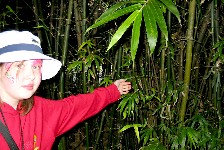 When we were in Disneyworld we noticed a lot of bamboo growing naturally on the grounds. It was also used decoratively in many places around Florida.
When we were in Disneyworld we noticed a lot of bamboo growing naturally on the grounds. It was also used decoratively in many places around Florida.We decided to find out more about this plant ... everyone seems to be familiar with it, but it isn't much studied in school. We certainly didn't know that much about it before we did some research. Have a look at what we found. 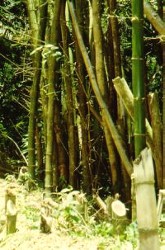 Bamboo is a type of grass, and there are many varieties. Some are as short as 30 centimetres, while giant timber bamboo can grow to over 40 metres high. Bamboo grows in a lot of different climates, both temperate and tropical. It can be found high on mountainsides, and in the jungle.
Bamboo is a type of grass, and there are many varieties. Some are as short as 30 centimetres, while giant timber bamboo can grow to over 40 metres high. Bamboo grows in a lot of different climates, both temperate and tropical. It can be found high on mountainsides, and in the jungle.As a member of the grass family, bamboo can be recognized by the special structure of its stem, or 'culm', and also by its rapid rate of growth, and its flowering. Bamboo does not flower every year, but once every 7 to 120 years, depending on the species, and usually dies after flowering. Once matured, a bamboo stem remains the same size for the rest of its life. It doesn't grow higher or wider. It doesn't add a growth ring every year as trees do. Bamboo is flexible, bending in strong winds, but rarely breaking. The flexibility is due to its hollow culm, and the nodes, or joints, between segments. The culm, branches and leaves stay green throughout its life, even during winter. Some plants send runners out to establish new plants, while others, called 'clumpers', expand from the original plant. Usually tropical bamboos are clumpers, while temperate bamboos are runners. 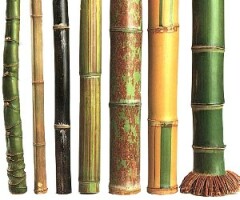 With a tensile strength superior to mild steel, and a weight-to-strength ratio better than graphite, bamboo is the strongest growing woody plant on earth. Its 1500 species cover a variety of habitats; it's found on all of the continents except Antarctica.
With a tensile strength superior to mild steel, and a weight-to-strength ratio better than graphite, bamboo is the strongest growing woody plant on earth. Its 1500 species cover a variety of habitats; it's found on all of the continents except Antarctica.Bamboo is the fastest growing plant. Some varieties can grow as fast as Bamboo is both decorative and useful. In many parts of the world it is food for people, fodder for animals, an important construction material, and is also used for making a great variety of useful objects. 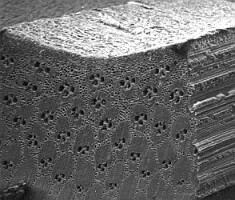 The lifespan of a single bamboo plant is not very long, only about 20 years. A fully mature bamboo plant sends most of the nutrients manufactured in its leaves down through tubes in its stem (called 'vascular bundles'), which run vertically down the culm, to the plant's roots. You can see a section of these tubes in the microscopic view at the left.
The lifespan of a single bamboo plant is not very long, only about 20 years. A fully mature bamboo plant sends most of the nutrients manufactured in its leaves down through tubes in its stem (called 'vascular bundles'), which run vertically down the culm, to the plant's roots. You can see a section of these tubes in the microscopic view at the left. The vascular bundles are what makes bamboo strong. They are similar to the steel rods in reinforced concrete, and make bamboo, when it has been laminated, as strong as soft steel. The vascular bundles also make it easy to split bamboo stems vertically, increasing the number of uses. The roots, called 'rhizomes', are where new plants are formed. New bamboo shoots are produced every year from these rhizomes. Madake is a type of bamboo that apparently flowers only once every 120 years. All types of bamboo flower only seldom, and remarkably, all the bamboo of a given species flowers at exactly the same time. Even if the bamboo is transplanted to different places, it will flower at the same time.  The uses for bamboo are many. Bamboo charcoal makes a good fuel, and because it is three times as porous as wood, it also removes odors effectively. When burned, bamboo releases more energy than wood. Plywood made from bamboo ('plyboo') is used for wall paneling and floor tiles, and as raw material for house construction.
Bamboo shoots provide nutrition for millions of people worldwide. The people of Taiwan, for example, consume over 70,000 tonnes of bamboo shoots annually. The uses for bamboo are many. Bamboo charcoal makes a good fuel, and because it is three times as porous as wood, it also removes odors effectively. When burned, bamboo releases more energy than wood. Plywood made from bamboo ('plyboo') is used for wall paneling and floor tiles, and as raw material for house construction.
Bamboo shoots provide nutrition for millions of people worldwide. The people of Taiwan, for example, consume over 70,000 tonnes of bamboo shoots annually. Bamboo leaves are sometimes used as fodder for animals; young bamboo leaves and twigs are a favorite meal for elephants and Pandas. 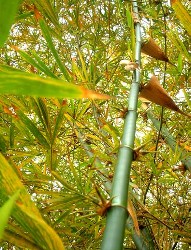 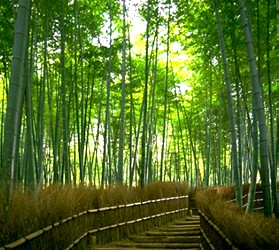 |